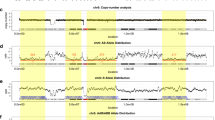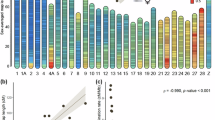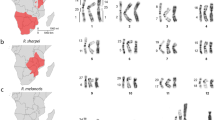Summary
The relationship between heterozygosity and the probability of monomorphism. is evaluated under several competing hypotheses. It is shown that such a relationship alone has very little discriminatory power in distinguishing between the alternative hypotheses unless the selection pressure is quite strong.
Similar content being viewed by others
Article PDF
References
Chakraborty, R, and Nei, M. 1976. Hidden genetic variability within electromorphs in finite populations. Genetics, 84, 385–393.
Chakraborty, R, Fuerst, P A, and Nei, M. 1977. A comparative study of genetic variation within and between populations under the neutral mutation hypothesis and the model of sequentially advantageous mutations. Genetics, 86, s10–s11.
Chakraborty, R, Fuerst, P A, and Nei, M. 1978. Statistical studies on protein polymorphism in natural populations. II. Gene differentiation between populations. Genetics, 88, 367–390.
Fuerst, P A, Chakraborty, R, and Nei, M. 1977. Statistical studies on protein polymorphism in natural populations. I. Distribution of single locus heterozygosity. Genetics, 86, 455–483.
Kimura, M. 1968. Evolutionary rate at the molecular level. Nature, 217, 624–626.
Kimura, M, and Crow, J F. 1964. The number of alleles that can be maintained in a finite population. Genetics, 49, 725–738.
Kimura, M, and Ohta, T. 1971. Theoretical Aspects of Population Genetics. Princeton University Press, Princeton, N.J.
Kimura, M, and Ohta, T. 1975. Distribution of allelic frequencies in a finite population under stepwise production of neutral alleles. Proc Natl Acad Sci USA, 72, 2761–2764.
Li, W-H. 1977. Maintenance of genetic variability under mutation and selection pressures in a finite population. Proc Natl Acad Sci USA, 74, 2509–2513.
Morton, N E, and Rao, D C. 1975. Monomorphism and heterozygosity. Heredity, 34, 427–431.
Nei, M. 1975. Molecular Population Genetics and Evolution. North-Holland, Amsterdam.
Nei, M, Chakraborty, R, and Fuerst, P A. 1976. Infinite allele model with varying mutation rate. Proc Natl Acad Sci USA, 73, 4164–4168.
Ohta, T. 1976. Role of very slightly deleterious mutations in molecular evolution and polymorphism. Theor Pop Biol, 10, 254–275.
Ohta, T, and Kimura, M. 1973. A model of mutation appropriate to estimate the number of electrophoretically detectable alleles in a finite population. Genet Res, 22, 201–204.
Selander, R K. 1976. Genie variation in natural populations. In Molecular Evolution, ed. F. J. Ayala, pp. 21–45. Sinauer Assoc., Sunderland, Mass.
Watterson, G A. 1977. Heterosis or neutrality? Genetics, 85, 789–814.
Author information
Authors and Affiliations
Rights and permissions
About this article
Cite this article
Chakraborty, R., Yokoyama, S. Heterozygosity and monomorphism reconsidered. Heredity 41, 327–333 (1978). https://doi.org/10.1038/hdy.1978.103
Received:
Issue date:
DOI: https://doi.org/10.1038/hdy.1978.103



